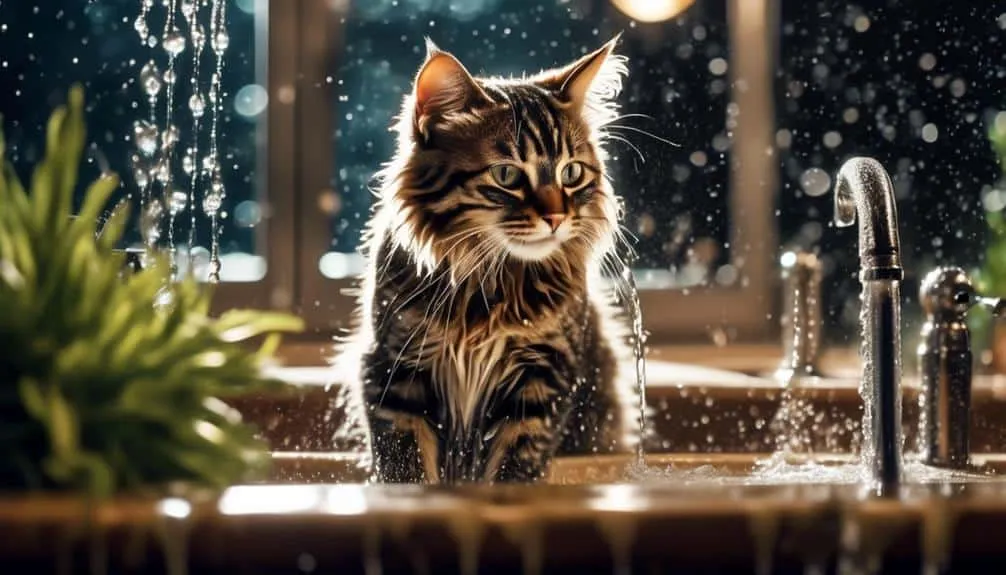The Best Fluffy Pancakes recipe you will fall in love with. Full of tips and tricks to help you make the best pancakes.

In the fascinating world of feline behavior, one aspect that continues to puzzle researchers and captivate cat owners is their quirky water behavior. Cats have long been known for their aversion to water, but what lies behind their peculiar interactions with this essential element?
Whiskers and sensitivity, their preference for running water, the impact of stress and water level inconsistencies, and even bowl placement and anxiety are just some of the intriguing aspects we will explore in this insightful discussion.
But there is much more to uncover, including how poor eyesight can influence cats' water behavior and serve as a possible indicator of age-related decline. So, join us as we embark on a captivating journey through the mysterious world of cats' quirky water behavior, where surprises and revelations await.
Key Takeaways
- Cats' whiskers are highly sensitive and play a crucial role in their perception and environmental awareness.
- Cats have a natural preference for running water due to their ancestral habits and perceive it as fresher and safer.
- Inconsistent water levels can cause stress in cats, and keeping the water level consistent helps alleviate this.
- Bowl placement can contribute to cats' anxiety, and relocating the water bowl to a neutral location can help reduce their stress.
Whiskers and Sensitivity
Cats' whiskers, with their abundance of nerve endings and blood vessels, serve as highly sensitive sensory organs that contribute to their perception, environmental awareness, and ability to measure gaps accurately. Whiskers are deeply connected to the nervous system, increasing sensitivity and allowing cats to gather important information about their surroundings.
These specialized hairs aid in night vision by detecting even the slightest movement or change in air currents. In addition to their sensory function, cats' whiskers also play a role in grooming behavior. Cats use their whiskers to assess the tightness of spaces, enabling them to navigate through narrow areas without getting stuck.
They also use their whiskers to groom themselves, ensuring that their fur remains clean and free from tangles. This intricate function of cats' whiskers highlights their essential role in a cat's daily activities and overall well-being.
Preference for Running Water
Running water holds a special allure for feline companions. Cats have a natural inclination towards running water, perceiving it as fresher and safer than standing water. This preference can be attributed to their genetic predisposition, reflecting their ancestral habits.
To cater to this inclination, cat owners can consider using a cat water fountain, which provides the benefits of running water. Cat water fountains not only mimic the movement of a stream but also encourage cats to drink more water due to the enhanced taste and freshness.
Additionally, techniques such as placing multiple water bowls around the house, ensuring the water is always fresh and at a consistent level, and adding ice cubes to the water can also stimulate cats to drink more water.
Stress and Water Level
Inconsistency in water levels can lead to uncertainty and stress in feline companions. Cats, being creatures of routine, prefer stability in their environment. Any changes, including fluctuations in water levels, can disrupt their sense of security and cause distress.
Cats may paw at the water to gauge its level, indicating their desire for consistency. To relieve stress and maintain their well-being, it is essential to monitor their water intake regularly. By ensuring a constant and adequate water supply, owners can help alleviate any potential anxiety caused by inconsistent water levels.
This proactive approach is crucial in preventing dehydration-related health issues. By closely observing their feline companions' water behavior and taking steps to maintain a stable water level, owners can promote a calm and stress-free environment for their beloved cats.
Bowl Placement and Anxiety
The placement of a cat's water bowl can significantly impact their anxiety levels and overall well-being. Bowl placement effects are an important consideration for cat owners, as they can influence a cat's comfort and sense of security during water consumption.
Cats may feel anxious when their water bowl is placed in a position where they are facing a wall, as it limits their awareness of their surroundings. This can lead to a sense of vulnerability and unease. To alleviate anxiety, cat owners can consider relocating the water bowl to a more neutral location, where the cat has a clear view of their surroundings.
Additionally, providing water bowl alternatives, such as cat water fountains, can help cater to a cat's natural preference for running water and further reduce anxiety.
Poor Eyesight and Water Behavior
Cats with poor eyesight may exhibit specific behaviors related to water consumption. As their vision declines, cats may develop a preference for dipping their paws into the water instead of drinking directly. This dipping behavior serves as a way to gauge the depth of the water and avoid misjudging it due to their diminished eyesight.
Pawing at the water can also be an early sign of eyesight decline in aging cats, as they may struggle to locate the water surface accurately. It is important for cat owners to monitor these behaviors and seek veterinary attention for older cats showing signs of vision decline.
Conclusion
In conclusion, the exploration of cats' quirky water behavior has provided valuable insights into their unique preferences and sensitivities. By understanding the impact of stress, water level inconsistencies, bowl placement, and poor eyesight on feline well-being, cat owners can better address these behaviors and enhance the quality of their pets' lives.
The fascinating world of cats and water continues to intrigue and captivate, offering a deeper understanding of the complex relationship between these enigmatic creatures and the element that both fascinates and challenges them.








